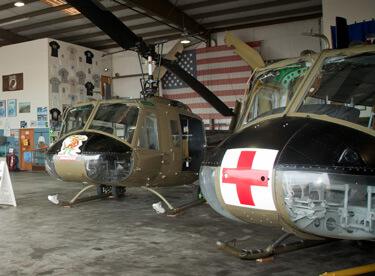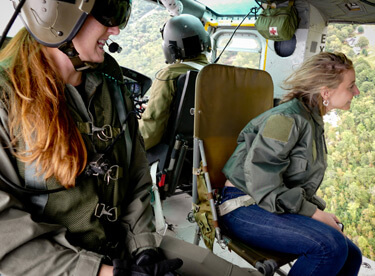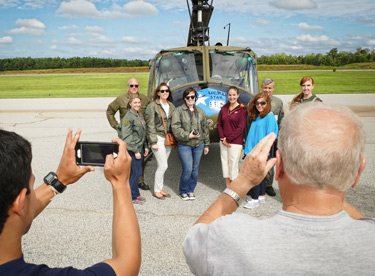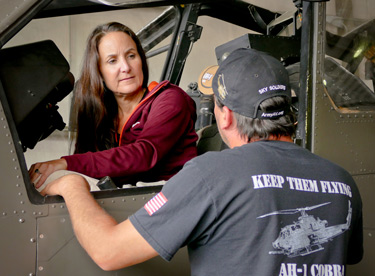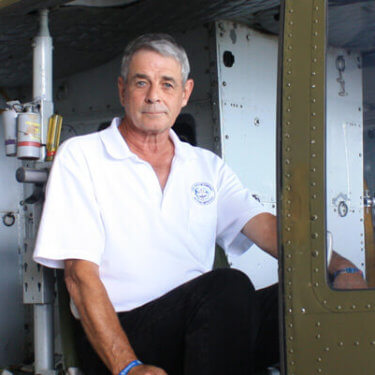
Cliff Stern
Army Aviation Heritage Foundation
-
- What is your background?
I spent 27 years in the army. I did two things – I flew helicopters and I was an engineer. I retired [from the Army] in 1993 and since then I have worked as a corporate engineer for Aramark Corporation, served as the director of facilities for the Olympic Village in 1996 and taught the graduate program in Integrated Facility Management at Georgia Tech for seven years. I had my own company after that and I am here today. - Why did you decide to go into the service or were you drafted?
I was 19 when I enlisted for the Army Security Agency in 1966. I was going to be a spy with a cape and a dagger. When I got there, they gave me a typewriter and a headset and I ended up intercepting Morse code. This led me to officer candidate school because [intercepting Morse code] wasn’t something I wanted to do long-term. - What was your primary role while in the army? I flew [helicopters] for ten years and I was an engineer for the rest of the time. My tours were in Vietnam and Fort Campbell, KY. I was an airfield commander in Germany and had pretty much all the airfield or aviation type assignments. Later, I was a Brigade S3 with an engineer brigade and Chief of Staff with the Corps of Engineers in the Southwestern Division in Dallas, TX which is where I retired from.
- How did you find out about the Army Aviation Heritage Foundation?
I was kidnapped. One day, four or five years ago my son told me “Dad, I want you over here about 9 o’clock in the morning.” I said, “Where are we going?” He said, “I can’t tell you.” To which I responded, “Then I am not going.” My wife explained to me that I was going so we got in his truck and drove down [to Hampton]. I thought we were going to the Speedway, then I heard a Huey cranking. That is how I got introduced to the Army Aviation Heritage Foundation. I hadn’t even thought about a helicopter in about 30 years. We took a ride that day and probably about six months later I became the Vice President and a year after that I became the President and a year after that I became the Executive Director and now I am sort of quasi-retired doing fundraising for the foundation.
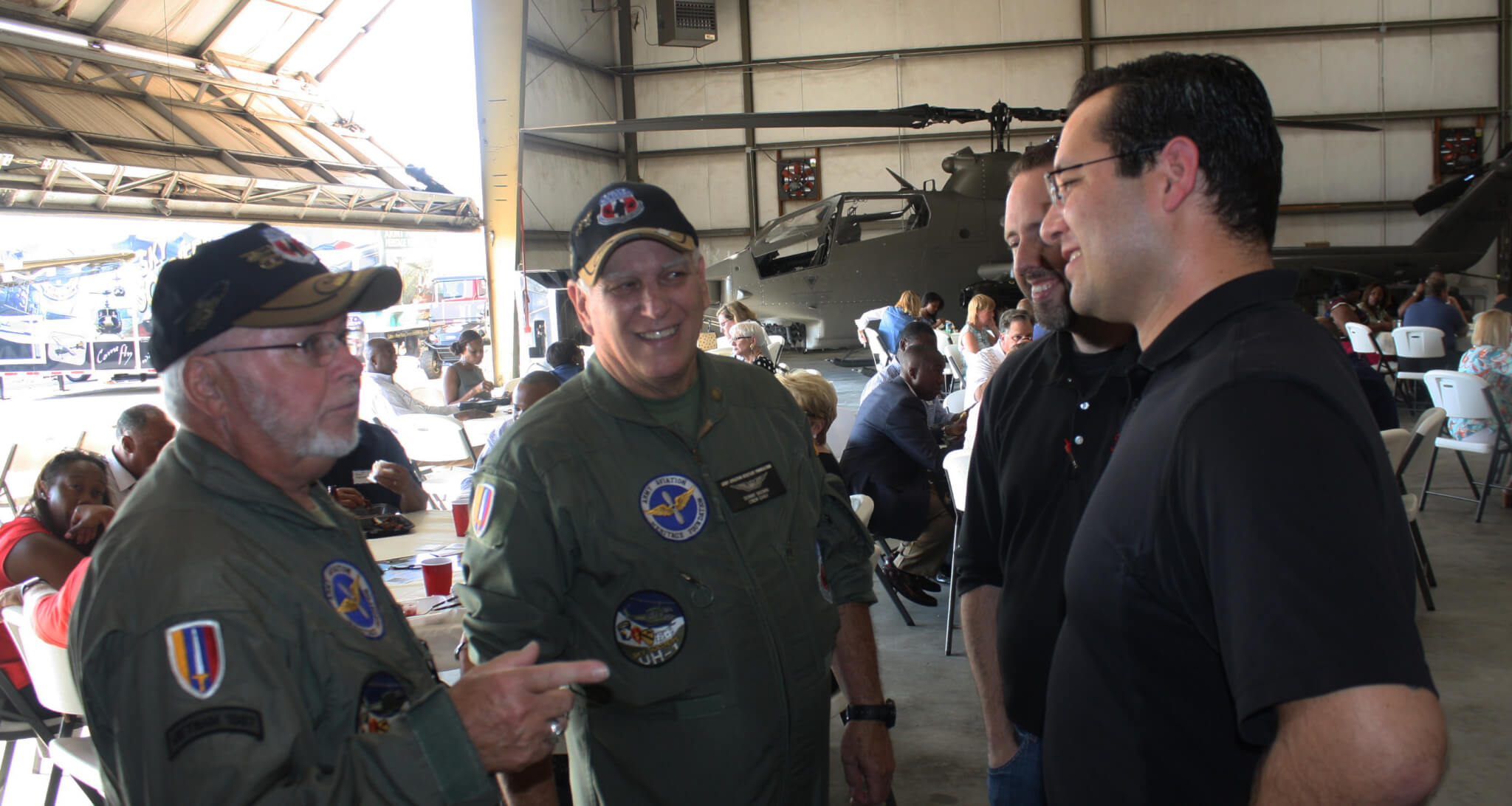
- What about the organization made you want to be involved?
I love the UH-1H Helicopter. I spent three years as an instructor pilot in that [aircraft] as well and I like to be around Vietnam veterans. The only people who actually know what went on there are Vietnam veterans so it is like Old Home Week. - How is the organization structured?
It is a membership organization. We recruit members and usually have between 800-1500 members. You do not have to be a veteran to be a member. In fact, my son is a lifetime member and his wife is also. - What is your current role and how has your involvement in the organization evolved?
I do fundraising and special projects. I have two projects I am working on now. For the last four months, I have been trying to find a Huey that I flew in Vietnam that the border patrol has and trying to get them to donate it to us. I also do grants and things like that. - What do you see as the mission of the AAHF?
I think it is pretty simple – we need to keep the Army Aviation history alive. All our aircraft with the exception of the Bird Dog are Vietnam aircraft. 58,456 men and women died in Vietnam and that would be the reason to keep the history alive. It is a war that was not very popular at the time. It took 10 or 20 years before people accepted the fact that we had done a reasonably good job.We also want to educate the public. We get a lot of riders that come to us during air shows and I have never seen anyone come off the aircraft that wasn’t smiling or crying (with joy). I have seen Vietnam veterans that have closed a door that they needed to close. We get all kinds of Vietnam veterans and their grandchildren saying “This is what grandpa flew.” All of our aircraft except for one have been in combat so they are the real deal. In fact, we have a member who flew one of the aircraft in Vietnam and another that flew the same aircraft in Germany so it has been around for a long time.I think it is pretty simple – we need to keep the Army Aviation history alive. All our aircraft with the exception of the Bird Dog are Vietnam aircraft. 58,456 men and women died in Vietnam and that would be the reason to keep the history alive.
- In your experience, what has been the most rewarding part of being a part of this organization?
When you see people come off those aircraft who have hit their bucket list. They have done something really special. The veterans who have closed a door and they are happy about it and can go on with life now. It is very rewarding because everything is tangible and you can see the results pretty quick. For example, I belong to the 174th Alumni which was the unit I flew with in Vietnam. We had a door gunner whose wife wrote to us (174th Alumni) through our website and said he was sick and had never been able to join the organization. He wanted to join the organization and I didn’t know how sick he was. So we got that mechanism going. I get a call from his wife and he was in the hospital so things didn’t look good. We got his membership, he just wanted his membership documents. They overnighted it to me and I got them to her and she took them to him in the hospital. His last request was to fly in a Huey. He started to get better and I told him that if he comes down here, he lived up in North Georgia, if he could come down here we would certainly get him back in a Huey.Unfortunately, he passed away, but his last request was a ride in a Huey. His wife called here and asked if we could do that. I contacted my alumni organization and I said, “I’ll tell you what, if we can raise enough money to cover the full fuel costs we’ll go do it.” That was 9 O’clock in the morning. By noon we had the money. We did the fly over at the funeral and she wrote us a really nice letter saying that was so cool. When a Huey flies over it just makes the whole thing. We do those kinds of things too. You don’t’ see it on the ground necessarily, but when you do things like that you can go home feeling good about yourself. - What types of aircraft does the AAHF own?
We have four UH-1Hs (Hueys) and five AH-1Fs (Cobras] that are flyable and I bet we have another seven in the back that we haven’t brought up to flyable status yet. We have an OH58 that is now at our St. Louis Chapter and one Bird Dog which is a fixed wing aircraft. These are our critical resource. The Huey’s and the Cobra’s run around 50 years old and the Bird Dog was built in 1957. We own the UH-1Hs and we own the OH58. The AH-1F’s (Cobra) are on a special program from the Department of Defense because they are armament systems so we don’t really own those. The Bird Dog is on the same agreement from the State Department so we don’t actually own it either. We fly them and we take care of them and modify them we do what we need to do. They are just like they are ours we just don’t’ have the deed or title.
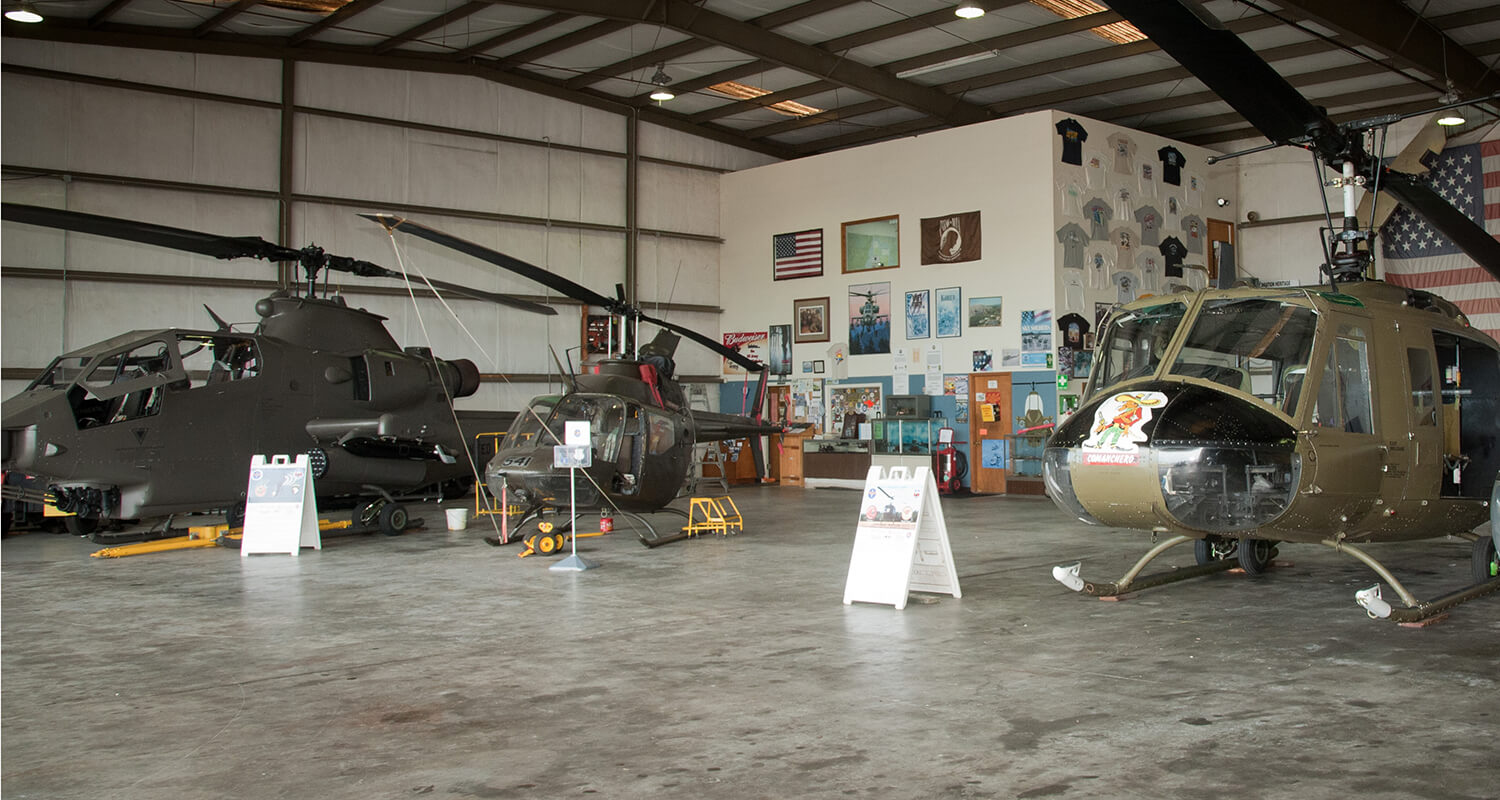
- What are the roles or uses of the different helicopters?
The UH-1H is basically a troop-carrying aircraft. It does resupply, it does medivac, It carries troops and there are 10 or 20 other things it does. A good term for what it does is “air mobility.”The AH-1F was the first helicopter that was designed as a weapons system. They entered the inventory in 1967. It carries all sorts of armament – rockets, 20-millimeter cannons and Gatling guns (miniguns). It was designed to be a weapons system. It has more power than the other aircraft. It is very maneuverable and it is only 3 feet wide when it is coming at you so it is very hard to combat. - What are the different ways people can see and/or experience the aircraft?
They can call [the hangar to schedule a tour or book a ride with a minimum of six people] and there is a schedule of the airshows [where rides are offered] on our website We did 82 events in 2015. In addition to the airshows, we do veterans’ funerals, fly-overs for parades and events like that. We work very closely with the Commemorative Air Force at Falcon Field trying to do joint events periodically. We do some local events also. These pre-arranged Huey rides require a minimum of six people. - As a non-profit, what role do volunteers play in the success of the organization?
They are the success of the organization. Without the volunteers, we would get nothing done. We have people that fly to Ypsilanti, Michigan for three days just to do rides and then they come back. They have done it because they just want to. They don’t’ get paid. Without the volunteers, we have nothing. We are a national organization and we have chapters in other places. We have a core group of about 20-30 people that are active and work out of this chapterThe foundation headquarters are attached to the Legacy Chapter which is here [at the Atlanta South Regional Airport in Hampton, GA]. We have a chapter in Ozark, AL called the Wiregrass Chapter, one in Meza, AZ called the Arizona Chapter, a provisional Chapter in St. Louis that is the St. Louis Chapter and we are looking at establishing a provisional Chapter in Tennessee. St. Louis and the Tennessee Valley do not have aircraft right now. The Wiregrass Chapter, the St. Louis Chapter, Arizona Chapter and the Legacy Chapter here have all the aircraft.I have over 2,000 hours in a UH-1H and my first ride in an AH-1F was amazing. It is a bucket list ride.
- On average, how much does it cost to maintain and fly the aircraft? As a target number, we use about $1,500 an hour of flight time [for a UH-1H]. Remember, these aircraft are all getting around 50 years old so parts aren’t readily available as they used to be. I would use similar [maintenance] costs for the AH-1F. The Huey holds 209 gallons if you figure it is somewhere between $4-$5/gallon that is $800-$1000. We get about two hours out of that. Because it takes a while to brief everyone, get them in the aircraft, hook them up, make sure they are safe, we only get four or five trips (rides) if we are lucky out of that fuel.When we first got UH-1Hs in the Army they cost about $250,000, now the engine itself cost that much. The transmission is relatively close to that amount. Even the rotator blades are $160,000 now. It is a lot more expensive to maintain them now than it was way back then. As these aircraft get older and you have to start replacing these major components, that’s where the big bucks come from. That is where I get the $1,500/hr. that we try to get to put into a maintenance fund.
- Can you tell us about the AAHF ride program?
Currently, about 85% of our existence comes from our ride revenue. We have the two different types of helicopters. We have the UH-1H and we can take 10 people up in that. The ride is probably 10-12 minutes and you get to experience everything during that 10-12 minutes that you would normally experience in a normal UH-1H ride. They have a very distinctive noise. I think another thing that draws people to us is if you think about the Vietnam War, the first comes to mind is the UH-1H. It is the icon of the war and that is another reason people come to us. The AH-1F gets a little better fuel economy than the UH-1H, but you only carry one person and that is why [the ride] is more expensive compared to the other aircraft. I have over 2,000 hours in a UH-1H and my first ride in an AH-1F was amazing. It is a bucket list ride. It is a different mission. We take troops around in a UH-1H drop them and fly off. AH-1Fs are there to do nothing but shoot rockets, and missiles and guns. When you go in the AH-1F you get to experience a return to target runs, how they do them and how they operate. You get to see exactly what a gun pilot did when that aircraft was in combat. The AH-1F has two rides options—a half ride and a whole ride just based on the expense of it.
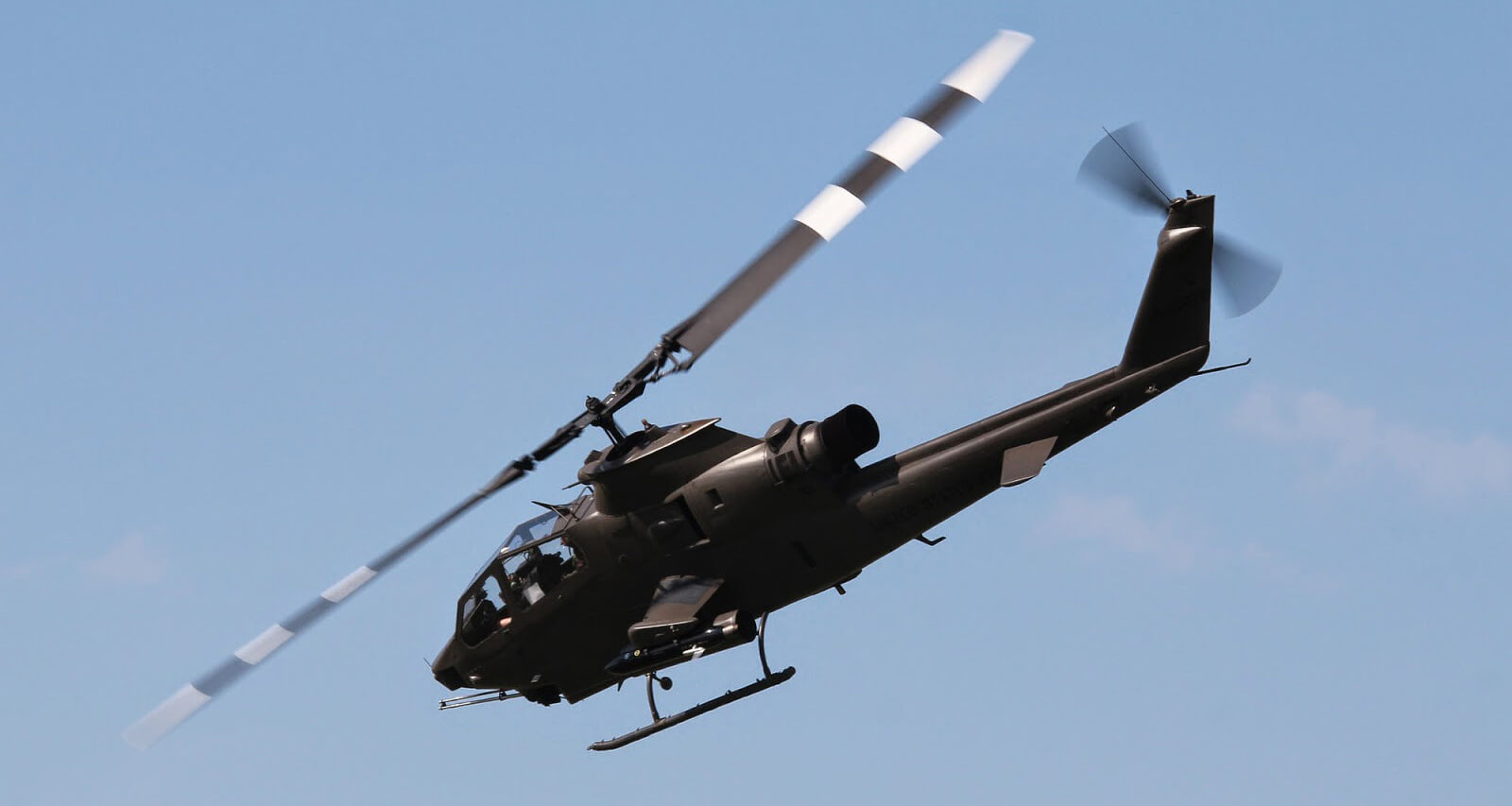
- What does the maintenance process for the aircraft involve?
When the aircraft are certified, the FAA had to also certify our maintenance program so we have a maintenance program that is pretty consistent with the way the military maintains their aircraft. It is step by step, check by check. We don’t cut any corners because it is our livelihood and we double check everything. In fact, I would say these aircraft here are maintained better than the aircraft I flew in Vietnam just because of the amount of time and effort we put toward them. We phase them every 12 and a half hours. A phase is an inspection and as it gets farther into that – in the 25, 50 and 100 hours we pretty much take the aircraft apart and put it back together again after checking all its components. That is called an annual which we do in the winter because that is when there aren’t any airshows.
- What is your background?
